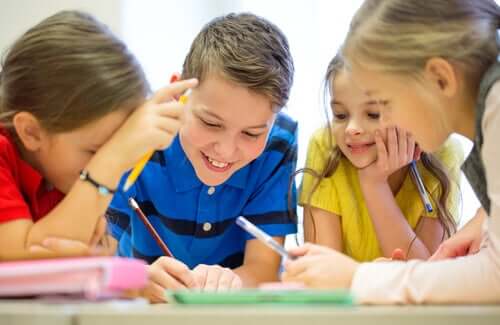The Benefits of Group Dynamics in the Classroom

To understand what we mean when we talk about group dynamics to work on in the classroom, we must first of all talk about what group dynamics actually is.
What is group dynamics?
Dynamics, or group dynamics, refer to the psycho-social discipline that studies and analyzes the qualifications, development, problems, forces and relationships of interdependence which occur within a group. The American psychologist of German origin, Kurt Lewin, was the pioneer in studying groups in this way.
This man sought to gain a better understanding of groups and how they work. He explained how their internal changes were due to forces and conditions that influence groups as a whole, and looked at how the members react.
Studying and analyzing the forces that occur within a group allow us to understand it better. It follows, then, that working on its dynamics would help improve how the group works together. So, how is all of this possible?

Group dynamics to work on in the classroom
Several group dynamics have been developed to work on groups and how they function. Many of them are suitable for working on in the classroom, if we consider the class to be a group.
These group dynamics, also known as group dynamics techniques, refer to systematized media or applied procedures. They aim to organize the group better and develop their activities.
Then, built on the knowledge base that the group dynamics theory provides, different activities and games are developed for the classroom. These are games and activities that can help the group achieve the proposed objectives and increase its effectiveness.
In the specific case of a class group, the dynamics will have the purpose of stimulating learning, socialization, creativity, cohesion, communication, cooperation, autonomy, responsibility, among other things. Besides this, they’ll help to solve problems and conflicts within the group.
There are well-known group dynamics techniques, such as the discussion group, role-playing, brainstorming, or Phillips 6.6, among others. These techniques have served as a basis for the development of other dynamics, activities, and games to work on with groups, all according to the particular characteristics of each group.
Some examples
Group dynamics are classified in many different ways, depending on the authors in question. But, in nearly all cases, there are common conditions such as the objectives pursued, the maturity of the group, its size, its environment, or the characteristics of its members.

All group dynamics to work on in the classroom must take these into account, and other conditions too. Here are some examples of them:
- Dynamics to work on communication and co-operation: The great mural
In groups of six students, they must agree on an idea that should be represented in a big drawing. The objective of this dynamic is to enhance communication and consensus among group members based on teamwork, active listening, and respect for the opinions of others. - Dynamics to work on communication, motivation and provide guidance for the task: Interviews in pairs
In pairs, they’ll ask questions alternately about a specific topic which corresponds to the school subject. The objective of this dynamic is to inquire about students’ prior knowledge and use it to trigger inspiration to work on the topic in greater depth. - Dynamics to achieve the resolution of a problem and work on creativity: How do we solve this?
Students should give guidance and possible solutions to a problem. This may be, for example, how to overcome the fear of darkness or how to overcome shyness. The objective of this dynamic is to provide creative solutions and ideas, and discuss problems that can affect us all.
To understand what we mean when we talk about group dynamics to work on in the classroom, we must first of all talk about what group dynamics actually is.
What is group dynamics?
Dynamics, or group dynamics, refer to the psycho-social discipline that studies and analyzes the qualifications, development, problems, forces and relationships of interdependence which occur within a group. The American psychologist of German origin, Kurt Lewin, was the pioneer in studying groups in this way.
This man sought to gain a better understanding of groups and how they work. He explained how their internal changes were due to forces and conditions that influence groups as a whole, and looked at how the members react.
Studying and analyzing the forces that occur within a group allow us to understand it better. It follows, then, that working on its dynamics would help improve how the group works together. So, how is all of this possible?

Group dynamics to work on in the classroom
Several group dynamics have been developed to work on groups and how they function. Many of them are suitable for working on in the classroom, if we consider the class to be a group.
These group dynamics, also known as group dynamics techniques, refer to systematized media or applied procedures. They aim to organize the group better and develop their activities.
Then, built on the knowledge base that the group dynamics theory provides, different activities and games are developed for the classroom. These are games and activities that can help the group achieve the proposed objectives and increase its effectiveness.
In the specific case of a class group, the dynamics will have the purpose of stimulating learning, socialization, creativity, cohesion, communication, cooperation, autonomy, responsibility, among other things. Besides this, they’ll help to solve problems and conflicts within the group.
There are well-known group dynamics techniques, such as the discussion group, role-playing, brainstorming, or Phillips 6.6, among others. These techniques have served as a basis for the development of other dynamics, activities, and games to work on with groups, all according to the particular characteristics of each group.
Some examples
Group dynamics are classified in many different ways, depending on the authors in question. But, in nearly all cases, there are common conditions such as the objectives pursued, the maturity of the group, its size, its environment, or the characteristics of its members.

All group dynamics to work on in the classroom must take these into account, and other conditions too. Here are some examples of them:
- Dynamics to work on communication and co-operation: The great mural
In groups of six students, they must agree on an idea that should be represented in a big drawing. The objective of this dynamic is to enhance communication and consensus among group members based on teamwork, active listening, and respect for the opinions of others. - Dynamics to work on communication, motivation and provide guidance for the task: Interviews in pairs
In pairs, they’ll ask questions alternately about a specific topic which corresponds to the school subject. The objective of this dynamic is to inquire about students’ prior knowledge and use it to trigger inspiration to work on the topic in greater depth. - Dynamics to achieve the resolution of a problem and work on creativity: How do we solve this?
Students should give guidance and possible solutions to a problem. This may be, for example, how to overcome the fear of darkness or how to overcome shyness. The objective of this dynamic is to provide creative solutions and ideas, and discuss problems that can affect us all.
All cited sources were thoroughly reviewed by our team to ensure their quality, reliability, currency, and validity. The bibliography of this article was considered reliable and of academic or scientific accuracy.
- Johnson, B. A. N. Y. (1981). La dinámica de grupo en la educación. Aguilar. l980.
- Vivas, P., Rojas Arredondo, J., y Torres Virgili, M. E. (n.d.). Dinámica de grupos. Universitat Oberta de Catalunya. Material docente de la UOC. Recuperado de https://www.psyciencia.com/wp-content/uploads/2012/11/DINA_MICA-DE-GRUPOS.pdf
This text is provided for informational purposes only and does not replace consultation with a professional. If in doubt, consult your specialist.








